2 ETFs in danger of breaking support
Stocks spent the first half of Monday
consolidating in a tight and narrow range near the previous day’s lows, but a
sharp mid-day selloff resulted in losses across the board. The bearish “inverted
hammer” candlestick patterns that formed on daily charts of the major indices
last Friday followed through to the downside. Small and mid-cap stocks showed
the most relative weakness, as both the Russell 2000 and S&P 400 indices fell
1.0%. The Nasdaq Composite
(
COMP |
Quote |
Chart |
News |
PowerRating) and S&P 500
(
SPX |
Quote |
Chart |
News |
PowerRating) each lost 0.7%,
while the Dow Jones Industrial Average
(
DJX |
Quote |
Chart |
News |
PowerRating) dropped 0.6%. Each of the major
indices closed around the bottom 20% of their intraday ranges and near support
of their 20-day moving averages.
Turnover levels were mixed yesterday, as total volume in the
NYSE increased by 7%, but volume in the Nasdaq was 10% lighter than the previous
day’s level. The losses on higher volume made yesterday the third “distribution
day” in the S&P within the past five sessions. Volume also came in above 50-day
average levels in each of those three days, confirming the institutional
selling. Because the Nasdaq has had one “accumulation day” and only two
“distribution days” within the same period, it seems the underlying internals in
the Nasdaq are a bit more positive. While a healthy market can typically absorb
one or two bouts of institutional selling within a several week period, the
presence of three or more “distribution days” serves as a warning to astute
traders.
Two sector ETFs we recently discussed as continuing to show
relative strength are now in danger of breaking support:
(
GLD |
Quote |
Chart |
News |
PowerRating) (iShares Gold
Trust) and IGW (iShares Semiconductor). Although both continued to act well
throughout last week, yesterday’s action in both ETFs was not good. GLD, which
bounced off support of its 50-day MA on February 16, fell back below support of
its 20-day MA and closed just above its 50-day MA. More importantly, it has
formed a “lower high” and is now in danger of breaking its four-month uptrend
line that has been in place since the November 4 low. If you are long GLD,
consider keeping a tight stop just below yesterday’s low in order to protect
against a break of the uptrend line and 50-day MA:
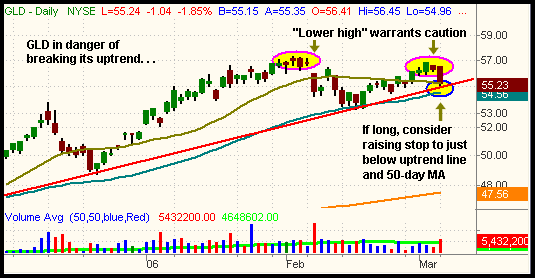
IGW was recently acting well, as the ETF bounced perfectly off
support of its 50-day MA on March 1 and consolidated near its 52-week high in
the latter half of last week. However, recent bad news out of sector giant Intel
seems to have spooked investors and traders away from the Semiconductor Index.
Yesterday’s 0.9% slide caused IGW to give back more than two-thirds of its gain
since the February 28 low. Like many other sectors and the broad-based ETFs as
well, it closed back below its 20-day MA and just above its 50-day MA. If long
IGW, we again recommend tightening your stop to just below the 50-day MA:
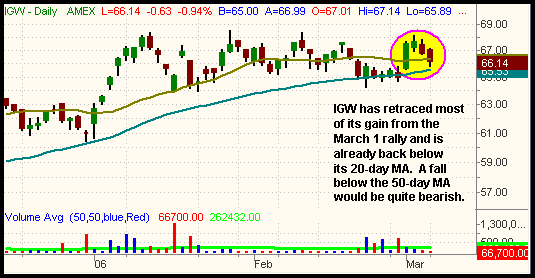
As expected,
(
OIH |
Quote |
Chart |
News |
PowerRating) (Oil Service HOLDR) has begun to resume
its five-week downtrend after failing to overcome resistance of its 50-day MA
last week. OIH plummeted more than 4% yesterday and will likely test support of
its February low in the coming days. If short, consider covering and locking in
profit on that imminent test of support, at least on partial share size.
Based on yesterday’s action, it appears that an end to the
broad market’s recent volatility contraction may be just around the corner. In
yesterday’s
Wagner Daily, we
looked at the key support levels of the three most popular broad-based ETFs:
SPY, QQQQ, and DIA. Both SPY and QQQQ closed only pennies above support of their
February 28 lows, while DIA closed just below it. Looking at the daily chart of
SPY, notice how it closed only four cents above its February 28 low of 128.13,
which it probed below on an intraday basis. Also notice how the 20-day moving
average has converged at that same support level as well:
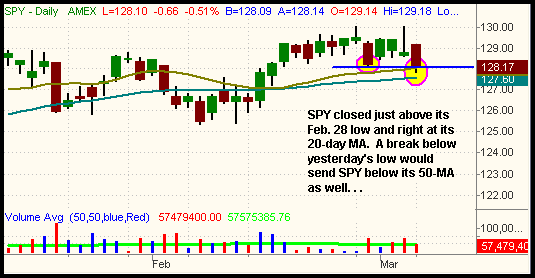
Going into today, traders will certainly be focused on
yesterday’s low in the S&P 500 because a break below that level would cause the
index to close below three key support levels: the February 28 low, the 20-day
MA, and the 50-day MA. We remain short SPY from our original entry at
129.04 and are presently showing a decent profit, but we will be on alert for
signs of a possible reversal off convergence of these pivotal support levels. A
rally back above yesterday’s high would be cause for concern on the bearish
side.
QQQQ also closed yesterday just above its February 28 low and
right at support of its 20-day moving average. The one difference, however, is
that QQQQ remains below its 50-day MA while SPY is still above it. This creates
additional selling pressure in the Nasdaq 100, although the more diversified
Nasdaq Composite is still above its 50-day MA. As the chart below illustrates, a
selloff down to the 200-day moving average in QQQQ seems likely if it
closes firmly below yesterday’s low:
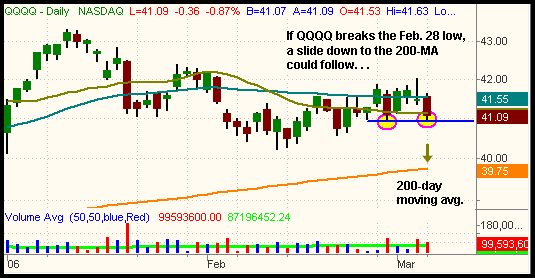
Curiously, the index that showed the most relative strength
last month, the Dow Jones Industrial Average, has failed to hold February’s
breakout to a new multi-year high. DIA (and the Dow Jones) finished yesterday
below its February 28 low, its 20-day moving average, and at a three-week low.
Support of its 50-day MA is now less than 0.5% below yesterday’s closing price:
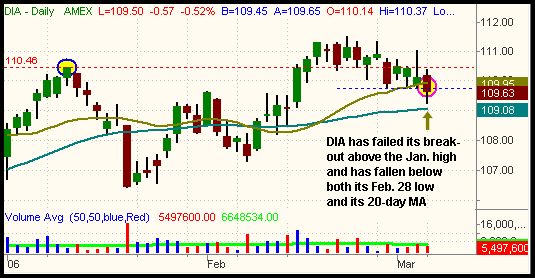
With so many indices and industry sectors sitting at
closely-watched support levels, now is not the time to be complacent
about your positions. Be prepared for a swift move in either direction and
consider tightening stops on both long and short positions. Don’t be overly
opinionated about which way you anticipate the markets to go from here. Instead,
simply listen to the market and it will clearly show you the way to go. Above
all, remember to trade what you see, not what you
think!
Open ETF positions:
Short SPY (regular subscribers to
The Wagner Daily
receive detailed stop and target prices on open positions and detailed setup
information on new ETF trade entry prices. Intraday e-mail alerts are also sent
as needed.)
Deron Wagner is the head trader of Morpheus Capital Hedge Fund and founder of
Morpheus Trading Group (morpheustrading.com),
which he launched in 2001. Wagner appears on his best-selling video, Sector
Trading Strategies (Marketplace Books, June 2002), and is co-author of both The
Long-Term Day Trader (Career Press, April 2000) and The After-Hours Trader
(McGraw Hill, August 2000). Past television appearances include CNBC, ABC, and
Yahoo! FinanceVision. He is also a frequent guest speaker at various trading and
financial conferences around the world. For a free trial to the full version of
The Wagner Daily or to learn about Deron’s other services, visit
morpheustrading.com or send an e-mail to
deron@morpheustrading.com .
Â
